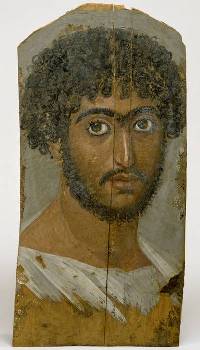Aug 14 2014
He looks almost Byzantine or Greek, gazing doe-eyed over the viewer’s left shoulder, his mouth forming a slight pout, like a star-struck lover or perhaps a fan of the races witnessing his favorite charioteer losing control of his horses.
 “Bearded Man, 170-180 A.D.” from the Walters Art Museum collection, object #32.6
“Bearded Man, 170-180 A.D.” from the Walters Art Museum collection, object #32.6
In reality, he’s the “Bearded Man, 170-180 A.D.,” a Roman-Egyptian whose portrait adorned the sarcophagus sheltering his mummified remains. But the details of who he was and what he was thinking have been lost to time.
But perhaps not for much longer. A microscopic sliver of painted wood could hold the keys to unraveling the first part of this centuries-old mystery. Figuring out what kind of pigment was used (whether it was a natural matter or a synthetic pigment mixed to custom specifications), and the exact materials used to create it, could help scientists unlock his identity.
“Understanding the pigment means better understanding of the provenance of the individual” said Darryl Butt, a Boise State University distinguished professor in the Department of Materials Science and Engineering and associate director of the Center for Advanced Energy Studies (CAES). “Where the pigment came from may connect it to a specific area and maybe even a family.”
For years, researchers were limited by the lack of samples large enough to be properly analyzed. But advances in the field of nanotechnology mean scientists now can work with fragments tinier than the eye can even register. Using a $1.5 million ion beam microscope at CAES, Butt — along with CAES colleagues Yaqaio Wu and Jatu Burns, and Boise State student researchers Gordon Alanko and Jennifer Watkins — is working with a sliver of the wood portrait smaller than a human hair.
The team transferred the fragment to a sample holder using a tiny deer hair called an “eyelash.” Their biggest challenge was to move it to the equipment without losing it.
So far they have extracted five needle-tip sized fragments 20 nanometers wide (a nanometer is a billionth of a meter), as well as two thin foils. From that, they have been able to analyze and map out the chemistry of the material in three dimensions.
“So far we’ve learned that the paint is a synthetic pigment,” said Butt, who as an artist in his own right often mixes his own pigments for his paintings. “These are very vibrant pigments, possibly heated in a lead crucible. People thought that process had been developed in the 1800s or so. This could prove it happened a lot earlier.”
Butt and his team are analyzing a speck of purple paint, which is significant because the blue used to blend the purple hue was a precious pigment back in the day, signaling a prominent individual.
Their data is being analyzed by researchers from the Detroit Museum of Art, where a companion to the “Bearded Man” mummy resides. It's part of a project, titled APPEAR (Ancient Panel Paintings-Examination, Analysis, Research), a collaboration between 12 museums, including the British Museum in London and the Walters Art Museum in Baltimore, Maryland.
Butt got into solving art mysteries when he met Glenn Gates, a conservation scientist at the Walters Art Museum at a conference at Stanford University. Both are officers of a new section of the American Ceramic Society — the Art, Archaeology and Conservation Science division.
“This research was a gamble that we [materials scientists] could do some really cool stuff,” Butt said, noting that he would love to branch out into analyzing pottery and other ancient artifacts.
While studying the provenance of Roman-Egyptian mummies is something new at Boise State, many researchers in the art, geology, history, anthropology and even English departments are involved in what Butt likes to call ‘reverse engineering’ of objects of cultural heritage.
“This particular problem, that is of understanding a particle of pigment from a 2,000-year-old sarcophagus, is a bit unique in that it highlights some of the amazing tools that we have at Boise State and at CAES that could shed new light on problems associated with understanding human history,” he said.
Butt hopes that these and similar transdisciplinary projects will open up external research opportunities for students, including creation of a “pipeline” of students who travel to various user facilities or museums to carry out interdisciplinary research.
“Envision, for example, art students studying works of art using synchrotron radiation and bright x-rays at a national laboratory, while science and engineering students use their technical skills to unravel mysteries of materials used by ancient societies in the field or held by museums,” he said.
The idea can sound far-fetched even for those who are participating in the research, although there is a certain, sound logic to transdisciplinary work between the arts and the sciences.
“I never anticipated having an opportunity to work on a project like this as an undergraduate research assistant in an engineering discipline,” said Watkins, who is a junior majoring in materials science and engineering. “I've enjoyed being able to interact with other departments on campus and experience other facets of research that I otherwise would not have been exposed to. I think there is a very interesting niche for materials characterization in archaeological research.”
“The key to creating these external opportunities or internships for students requires that we develop a reputation as well as students with the right skills and mindset for this kind of work,” Butt said. “That’s what we’re doing now.”